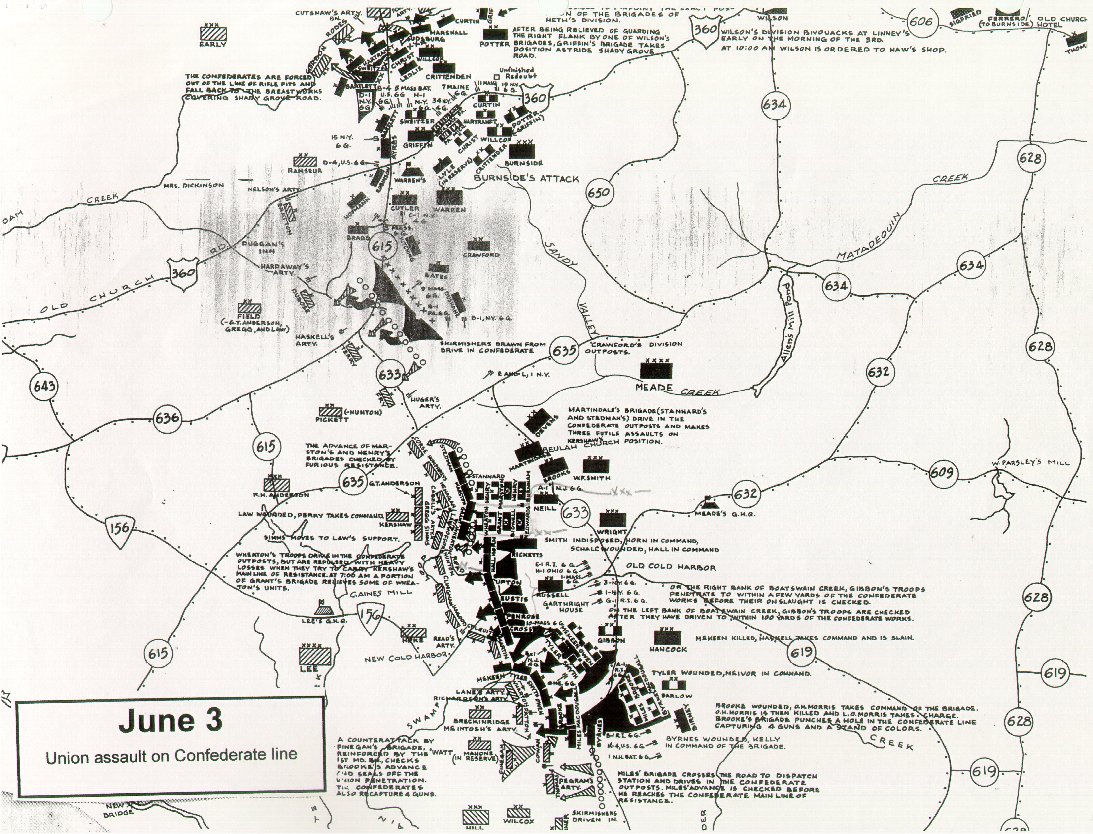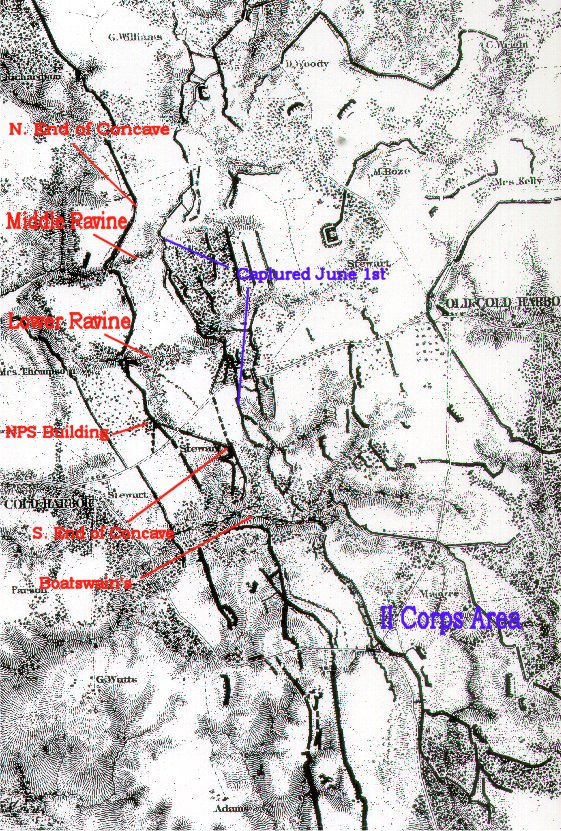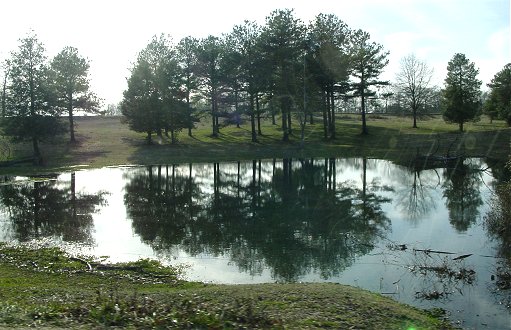
The Infamous Union Attack
June 3, 1864
After the promising June 1st attack, Grant planned to continue attacks early the next day. Hancock's II Corps did not arrive on the southern flank when expected so the attack was rescheduled for 4:30am on June 3rd. The Confederates had spent the extra day improving the lines. Warren pleaded that his V Corps was too dispersed to attack, and other corps commanders hinted that prospects were not encouraging, but they did not specifically state that an attack was foolhardy. Grant wrongly believed that Lee's army was demoralized and on the verge of collapse, and neither he nor Meade visited the front to investigate the situation. Although there were certainly many brave attacks that day, some Union units were becoming less eager to sacrifice themselves in hopeless attacks on entrenchments.


XVIII Corps Attacks Up the Middle Ravine
"Baldy" Smith and his newly arrived XVIII Corps from the Army of the James did not share the same costly experiences attacking entrenchments. Further, the corps was looked down upon by Army of the Potomac veterans. So it is understandable that the XVIII Corps attack was both brave and costly. Smith formed three narrow columns to advance along the middle ravine into what he expected would be a weak point. (Maps of the battle often place this attack further north along the upper ravine or even Sandy Valley Road, but Rhea's account convincingly puts it in the middle ravine.) Much of this ravine is on private property, and the cleared section shown in the picture is usually a pond, but it is shown here in the depth of drought more like it was during the battle.
Touring Advice: (For fall through spring when underbrush is lighter!) When you stop at the parking area on the north side of the park - behind the Confederate lines - walk left behind the entrenchments. Follow the entrenchments across the road as they somewhat angle back toward the creek. Soon you will see park service signs marking the boundary line. Since park land does not extend far, walk into the ravine and across the creek. Find and follow the northern park boundary. As you walk, you can see an open field to the left. The Confederate line bent into a V at the creek and extended through the field to your left behind the nearby house. You will emerge in the area shown on the left of the picture near the road cut. Nearby entrenchments must be Union ones built after the failed attack. The Confederate line returned to a north-south direction near where it met the road further north. This north-south line was also the June 1st Confederate line. As you walk back along the road toward your car, find a path on your right through the wooded ravine. A little way down the path along the slope on your left you may be able to find very shallow depressions. These are either Confederate rifle pits or pits dug by the attacking Federals, but judging from their regular spacing, they are probably Confederate. You can make your way up the slope and back to your car. Wasn't that fun?

VI Corps Attacks
Just south of the middle ravine is the area interpreted by the National Park Service, an area which was open at the time. The middle ravine is off the picture to the right. The Union VI Corps attack was in the direction of the road on the right of the picture, but advanced little beyond this point. This area is inside the concave Confederate line. When Smith contacted Horatio Wright, the commander of the VI Corps, to coordinate the attack, Wright simply said he would "pitch in", but only about 40% of the VI Corps made anything like a meaningful attack. Both the XVIII and II Corps would complain that to advance, they needed supporting attacks from the VI Corps. Unlike Warren, Wright did not specifically state that an attack was futile and instead made a token attack. Clearly there were serious personal and communications problems in the Army of the Potomac - between Grant and Meade - and between Meade and his corps commanders. Failure and needless sacrifice were the predicable result.

NPS Field
|
 |

II Corps Attack Area
South of Boatswains' Creek, A.P Hill's Third Corps and Breckinridge's division from the Valley had entrenched along the gentle ridges leading south to Turkey Hill and the Chickahominy River. This is the view looking west from the road leading south to the Chickahominy. (The pond shown does not normally exist as the picture was taken after a good deal of rain.) Winfield Scott Hancock's II Corps line was roughly along this road. Beyond the higher ground visible here, a gentle slope leads to another ridgeline upon which the Confederate main line rested. Hancock observed the formidable position, but he did not specifically tell Grant and Meade that an attack was foolhardy, only that he and his division commanders were not encouraged. Hancock attacked with two divisions in front and one in support. Of all the attacks that day, only the II Corps penetrated the Confederate line, but the Yankees were quickly stopped by a Confederate counterattack. As everywhere else, the Union troops dug in.
Fighting continued during the day with Burnside virtually repeating the Confederate attack of Bethesda Church several days before. The Union effort had failed. Casualty figures are not precisely known, but it is now thought that the Union army lost 3,500 to 4,000 men in the famous June 3rd attack versus around 1,000 Confederate losses, most of which occurred during Hancock's penetration. For the campaign as a whole, the Union army lost around 11,500 men to Confederate losses of around 6,000.